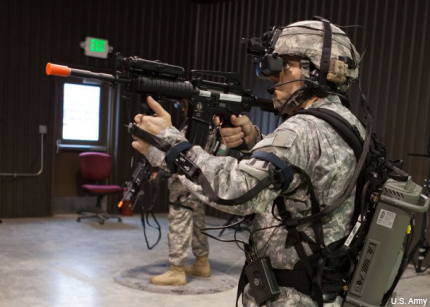Army wants simulations that don’t make soldiers sick
Simulator sickness is becoming a more common problem as training moves into virtual environments. The Army Research Institute is looking for an answer.

Soldiers conduct a session with the Dismounted Soldier Training System.
The military use of more sophisticated simulators as part of training is bringing to light an unfortunate side effect: Working in a virtual environment with a head-mounted display can make some soldiers feel sick.
The condition, called simulator sickness, isn’t new; it’s been known for as long as there have been immersive environments and simulators of any kind. Pentagon research on it dates back at least as far as the 1980s. But as simulators become a more common complement to live training, the effects are being felt.
“Unit training and readiness will be put at risk if these conditions continue,” according to the Army Research Institute for the Behavioral & Social Sciences, which has issued a solicitation for white papers on how to mitigate simulator sickness, particularly when using head-mounted displays.
In the solicitation, ARI notes that the Army’s Dismounted Soldier Training System (DSTS), which has been deployed at several locations, has drawn low usage rates. Perhaps not coincidentally, there also have been reports of soldiers experiencing simulator sickness after using the system.
DSTS is an immersive environment that includes use of a head-mounted display to create a combat scenario for up to nine soldiers for each session. Like other simulators, the Army sees it as important to training, both because it allows soldiers to train for potentially dangerous situations without risk, and it costs less than doing all training in live situations.
But it won’t do any good if soldiers don’t use it, and they’re not likely to use it if it makes them feel sick. And beyond just the loss in training from underuse, ARI said, the effects of simulation sickness are potentially dangerous.
Symptoms can include disorientation, dizziness, nausea, visual impairments and visual-perception flashbacks, which create a false sensation of movement after taking part in a virtual environment. The effects can last anywhere from a few minutes all the way to 24 hours, and could create safety risks during a number of activities, such as driving a vehicle, operating machinery or handling a weapon.
ARI is looking for input into how best to mitigate the effects, saying that an effective solution is essential to soldiers regaining their trust in virtual environments.
The makers of at least one other notable head-mounted virtual environment also are working on the problem — Oculus Rift, which has had difficulty with simulator sickness. Even the company’s CEO, Brendan Iribe, has said the experience made him sick. Oculus’ solution addresses display delay, one of the potential causes of simulator sickness ARI cites in its solicitation.
As reported by ReadWrite, Oculus Rift’s original DevKit 1 for developers used LCD technology for displays, which has slow motion-response times and causes motion blur. The prototype for DevKit 2 is using Organic LED, which isn’t as bright at LCD but delivers sharp movement without blurs. And Iribe, for one, said the new display technology had cleared up the problem for him.
Responses to ARI’s solicitation are due by July 1.




